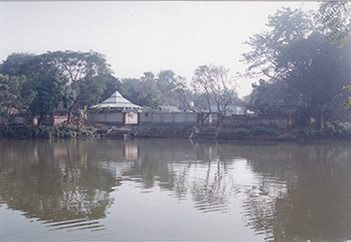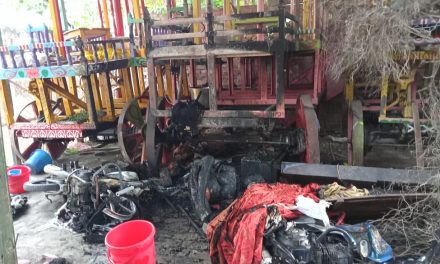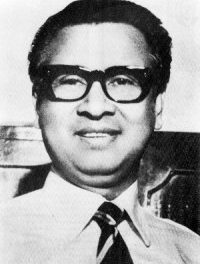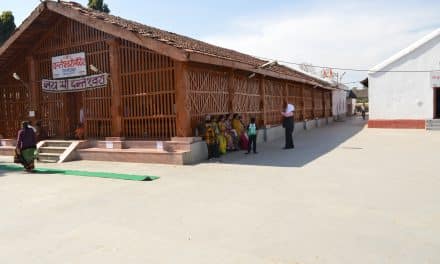‘Shree Aparna Shaktipeeth Bhabanipur Temple’ is one of fifty one Shaktipeethas. It has established itself as a fascinating destination for Hindu pilgrims and all the sectarians irrespectively from every corner of the Bangladesh and abroad. Like the others, it is also intertwined with a legendary anecdote inscribed in some Hindu religious texts. The temple, a holy abode of the Goddess ‘Sati’, is located on the bank of the river ‘Karatoya'(also spelt as ‘Korotoa’). This shrine is situated near Karatoyatat, 28 km (17.5 miles) away from Sherpur Upazila(sub-district) of Bogra District under Rajshahi Division, Bangladesh.
History that increases its attraction
A thrilling incident that continues to increase the attraction of the pilgrims daily to this historical shrine is when a conch bangles merchant once passed by the side of a lonely pond in a dense forest near the then Bhabanipur Temple. A little girl with a tip(small round paint put on the forehead) of vermilion on her forehead suddenly came to him and introduced herself as a child member of the Natore Rajbari(castle or palace). She purchased a set of conch bangles from him on a contract of collecting the price of that set of conch bangles from the then Maharani Bhabani of the Natore Rajbari from a particular basket that was kept in the castle at a specific place. The conch-bangles merchant became astounded and did so as she narrated.
Maharani Bhabani heard of it from him and did not waste a moment to be there with her courtiers and the conch-bangles merchant. But there was none like that girl child. It was indeed a wonder for the Maharani Bhabani and her court because none belonged like that of the little girl child to that royal family. There the conch-bangles merchant was the only person who earnestly prayed Ma Bhabani, and She responded to him by raising Her two wrists with a set of conch-bangles worn. To all, including Maharani Bhabani and her courtiers, it was a miraculous incident done by Ma(mother) Bhabani. This earned the fame of the temple over the subcontinent. That pond got the name ‘Shankha Pukur'(the pond of the Conch-bangles), which is still now considered a holy tank in which the pilgrims become ardent to take at least a dip before offering their pujas(worshipping) to Ma(mother) Bhabani.
Religious part narrated in the Hindu Scriptures in favour of the temple
The great epic, Mahabharata is only responsible for our knowledge that in the ‘Satya Yuga'(the first era of fours), the King Prajapati Daksha arranged a great yajna(sacrificial ritual) with its name ‘Brihaspatistava Yajna’ in which his younger daughter ‘Sati’ and son-in-law ‘Lord Shiva'(Lord of the universe) were not wanted whereas many eminences had been invited cordially. Devi Sati knew no bounds and attended the yajna arranged by Her father, King Daksha. But unfortunately, Her presence in that auspicious ceremony spoiled it when Her father, King Daksha, started to throw a lot of slang towards Her and Her beloved, Lord Shiva. Initially, Devi Sati tried her best to digest all this, but gradually it crossed its limitation to bear with. Then Devi Sati attempted to make her father calm down and understand. But he was insistent on a misunderstanding. Her highest tolerance was when she had nothing to decide to immolate herself into the yajna sacrificial altar. As a result, She had lost all her ways except death. The onlookers of that ceremony tried their best to bring out Her, but they, unfortunately, were only able to rescue Her dead body(corpse), which was yet to burn. Devi Sati’s beloved consort Lord Shiva was informed of this mishap within a moment. For a while, He became mournful for His beloved Devi Sati. But it was his natural characteristic that He became wrathful, which helped him to take his impersonation of ‘Veerbhadra’ and appear in the yajna. And it was enough for him to reason to demolish all the things of the yajna with His devoted companions, along with the decapitation of King Daksha, resurrected later by the Lord of the universe, Lord Shiva himself.
On the contrary, Lord Shiva carried the corpse of His beloved Devi Sati and was in the mood to destroy the universe with His ‘Tandava'(rampage). To save the universe Lord Vishnu was only the medium who utilised His ‘Sudarshan Chakra'(disc of auspicious vision) to turn the corpse of Devi Sati into pieces which fell over the subcontinent to make each one holy as a Shakti-Peetha later. It is a belief that here at Bhabanipur, Devi Sati’s left anklet had fallen, whereas according to various sources, Her ribs of the left chest or right eye or bedding fell here.
Temple’s accommodation and the denominations of the idols
With an enclosure around the area of four acres(twelve bighas) in which the temple complex is situated. And the numerous temples of various Hindu gods and goddesses make the place holy and attractive. Within the complex are Gopal Temple, Patal Bhairava Shiva Temple, Main Temple, four Shiva Temples, Belbaran Tala, Nat Mandir and Badudev Temple. To the north, outside the compound wall, there is also a Sheva Angan, four more Shiva Temples, two Bathing Ghats, Holy Shankha Pukur and a Panchamunda Asana.
Although there is no idol of Goddess Bhawani in this shrine, a Kali idol is worshipped in this temple. A stone is considered a symbol of Ma Sati’s left anklet, which was worshipped also. There the Shakti of Bhabanipur shrine is addressed yet as ‘Aparna'(one who is so lost in worship that even the falling of leaves goes unnoticed by her) and the ‘Bhairava’ as ‘Vaman’ or ‘Bamesh’.
According to ‘Peeth Nirnaya Tantra’ the Shakti of Bhabanipur is also regarded alternately as following names
Goddess Ma Bhabani: a powerful form of Ma Durga who rules the universe.
Arpana: one who is dedicated to Lord Shiva.
Tara Ma: said to be the most ferocious form of Durga.
Special rituals are held with several visions
Daily worshipping is performed in this shrine through several rituals with a few visions of marriage to a person of a girl’s choice, to keep health well and longevity of husband. So, here are the rituals which the devotees follow:
Early Morning: ‘Pravati’ and ‘Balyo Bhog'(feeding the boys)
Afternoon: The deity is worshipped with ‘Anna Bhog'(rice feeding)
At night: ‘Arati'(subjugation) and ‘Bhog’ are offered on behalf of the committee.
The devotees can offer ‘Bhog’ to the gods and goddesses daily and have ‘Prasad'(blessing) later on.
Festivals which are held in this shrine
Devotees enjoy a long list of festivities performed in this shrine at different seasons throughout the year. Among them, ‘Ram Nabomi’ appears first with a lot of amusement in the Bengali month of ‘Chaitra or Baishakh’ when a fair is also organised. Then comes another auspicious occasion, the name of ‘Maghi Purnima’ in the Bengali month of ‘Magh or Falgun’, when the moon radiates its silver light on devotees. Inseparably yagnas(sacrificial rituals), rounds of storytelling and unique arati(subjugation) come with these celebrations. With a religious belief, devotees dip in the ‘Skankha Pukur'(the pond of Conch-bangles) that helps cure skin-related ailments. Along with these festivals, some more festivities are held as auspicious occasions. They are:
Durgotshav in autumn(generally in the English month of October)
Dipanwita Shyama Puja in the Bengali month of Aghrahayan and finally
Nabanna is also in the Bengali month of Aghrahayan.
Facilities provided by the temple management
A committee was formed by the name “Bhabanipur Temple Development, Renovation and Supervision Committee” to take care of the temple and its properties. On the 13th of February, 2007, it was a sad day for the temple when Bangladesh armed military forces demolished the ‘Guest House’, which was under construction by the committee for the convenience of its devotees. This committee currently facilitates its tourists and pilgrims at every step of the day. It provides buses and cars for travelling and also arranges hotels for nighttime.
Dress code of the temple and things that should do or not inside the temple premises
Like a few of fifty-one Shakti-Peethas, Bhabanipur Temple maintains its dress code for both men and women. Men must wear a Shirt and Trousers, Dhoti or Pyjamas with upper cloth whereas women must prefer sharee or half-saree with a blouse or churidar with pyjama and upper cloth. Tourists and devotees must not choose Shorts, mini-skirts, middies, sleeveless tops, low-waist jeans and short-length T-shirts before entering the temple premises.
Tourists and pilgrims must bathe and wear clean clothes before entering the temple and be well-behaved with anyone. Smoking, drinking alcoholic drinks, chewing betel leaves, tobacco, gutkha and spitting inside the temple are strictly prohibited by order of temple authority.
Temple timing
The temple opens at 6:00 a.m. till 12:00 noon in the first half, reopens in the second half at 4:00 p.m., and closes for the day at 8:30 p.m.
How to reach
Among the three modes of communication, the roadway is a mass utilised and the most convenient way to reach the Bhabanipur Temple. From Dhaka via Jamuna Bridge passing Chandaikona in Sirajganj district, they can reach Ghoga Bat Tala Bus Stand, which is on the Bogra-Dhaka Highway and from there, they can reach the temple by availing van or scooter. Pilgrims from the districts located to the north of Bogra can reach the temple by passing through Sherpur, Mirzapur and Ghoga Bat Tala Bus Stand of Bogra district.
By Railway: ‘Santahar’ railway station is the nearest, which is 77.2 km away from the temple.
By Air: Bogra Airport, which is 30 km away from Sherpur and around 60 km from the temple. From there, local transportations take the tourists and devotees to the instep of the goddess Ma Aparna.
Postal Address: Bhabanipur Shaktipeeth, Karatoyatat, Sherpur Upazila(subdistrict), Bogra District, Bangladesh.
Main Image Copyright: Shaktipeeth Bhabanipur
















